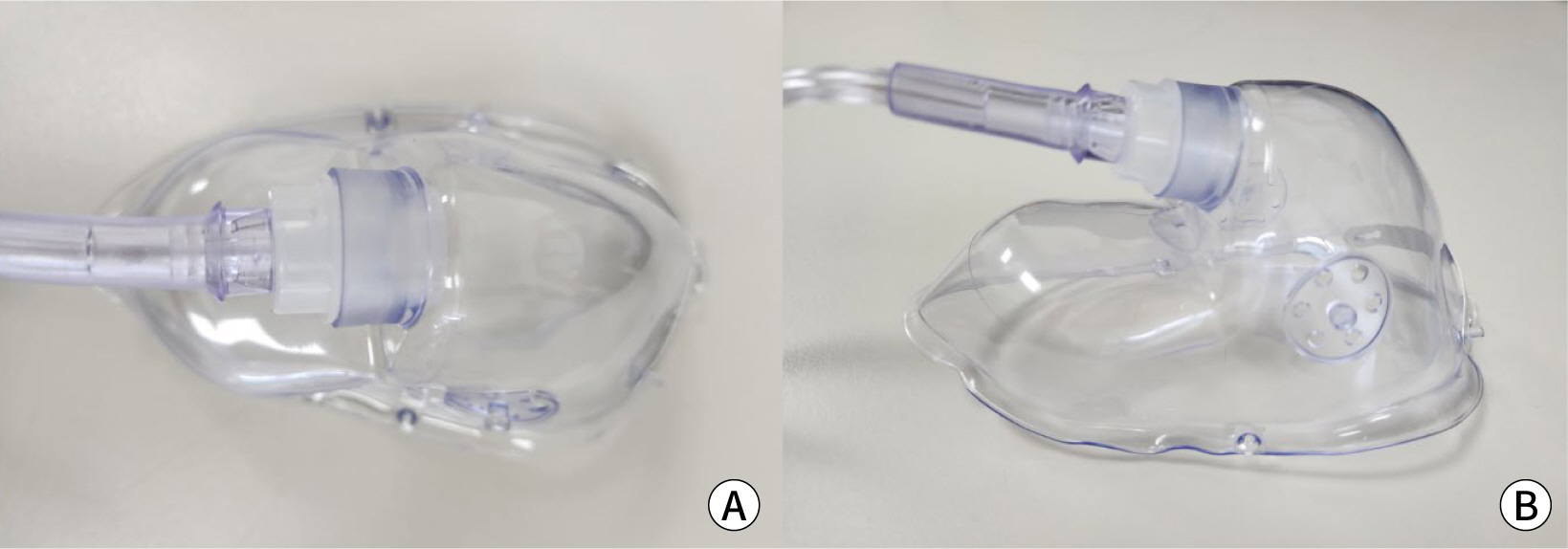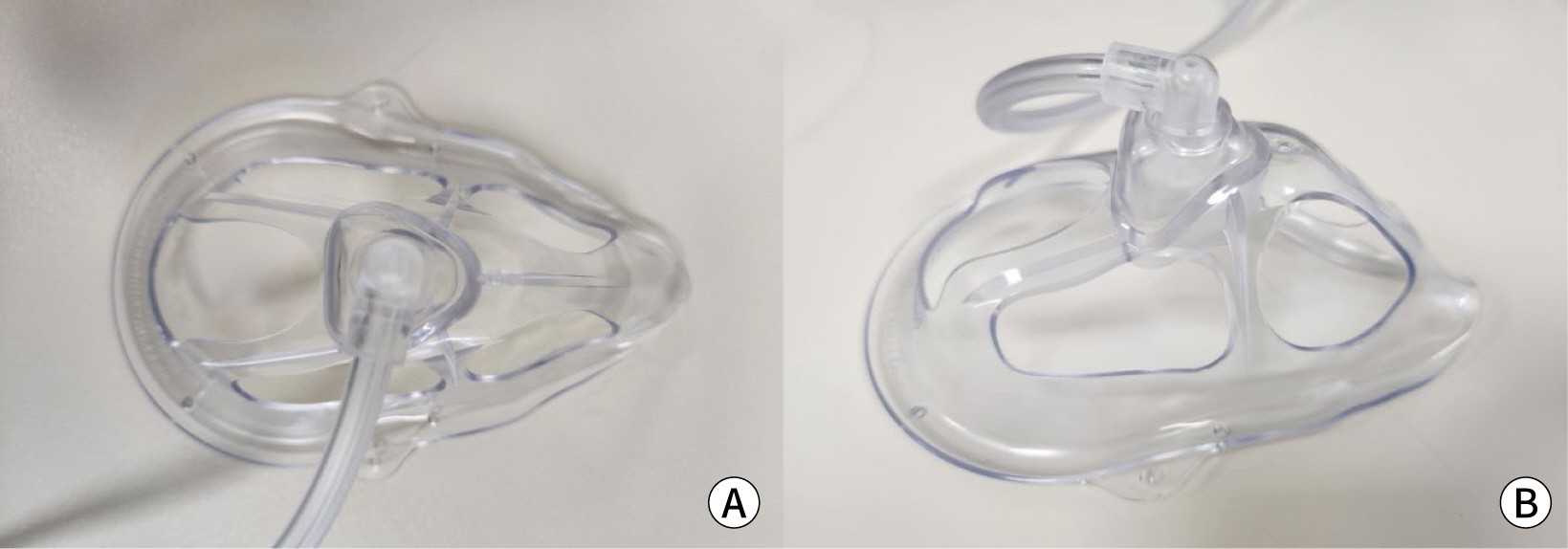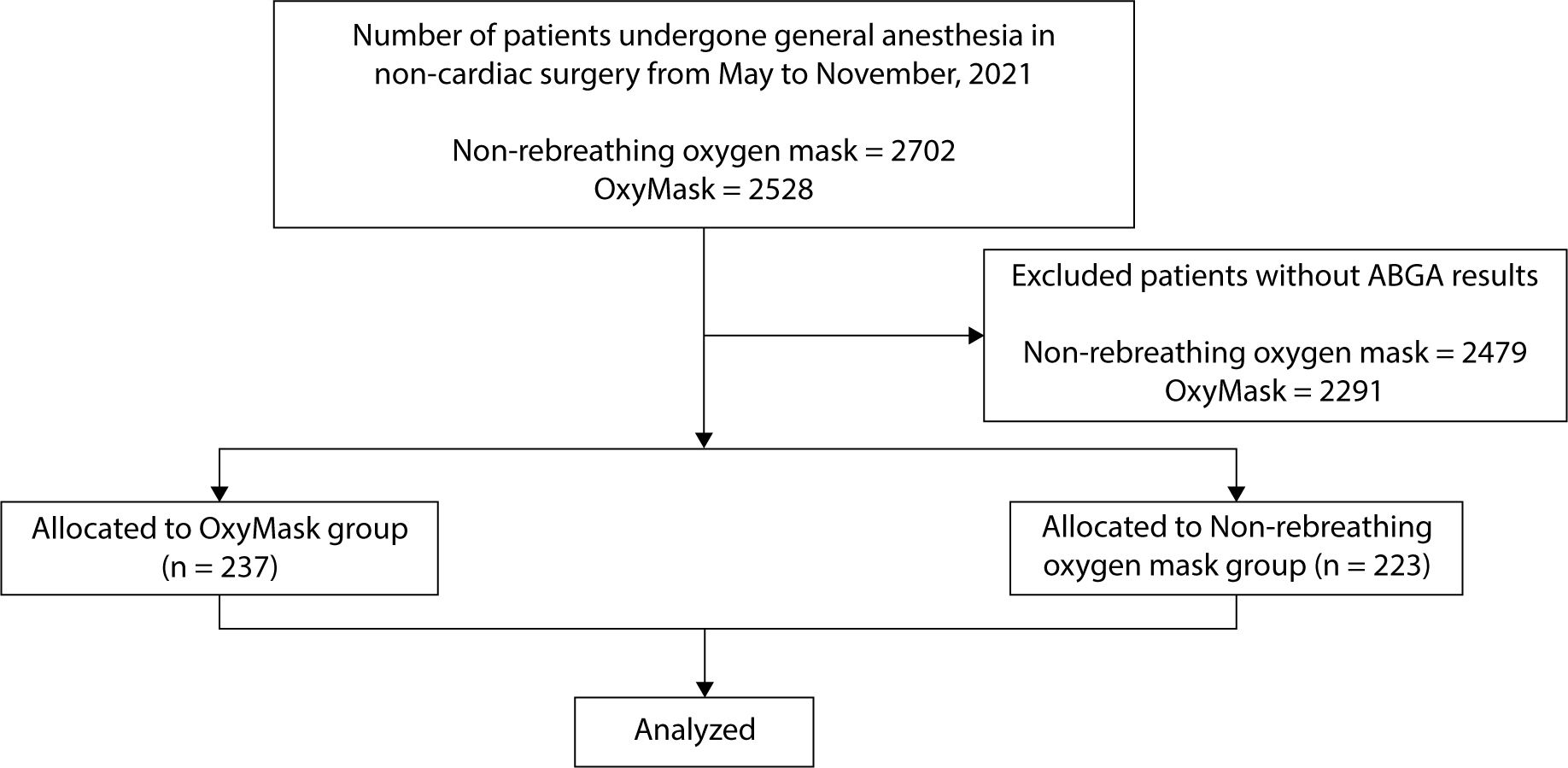Ewha Med J.
2024 Apr;47(2):e26. 10.12771/emj.2024.e26.
OxyMask is not superior to a non-rebreathing oxygen mask for oxygen supply in a post-anesthesia care unit in Korea: a comparative study
- Affiliations
-
- 1Department of Anesthesiology and Pain Medicine, Ewha Womans University College of Medicine, Seoul, Korea
- 2Department of Anesthesiology and Pain Medicine, Ewha Womans University Mokdong Hospital, Ewha Womans University College of Medicine, Seoul, Korea
- KMID: 2556315
- DOI: http://doi.org/10.12771/emj.2024.e26
Abstract
Objectives
OxyMask, a novel product, has recently been used to administer oxygen postoperatively to patients who have undergone general anesthesia. This study aimed to evaluate the incidence of hypoxia in patients under general anesthesia upon arrival to the post-anesthesia care unit (PACU) using arterial blood gas analysis, and to compare the effectiveness of OxyMask with a non-rebreathing oxygen mask for oxygen administration.
Methods
We retrospectively investigated anesthesia-related data from the electronic medical records of 460 patients treated from April to November 2021. We analyzed patients aged 20 years or older who had undergone general anesthesia and whose perioperative arterial blood gas analysis results were available upon arrival to the PACU. These patients were grouped into the non-rebreathing oxygen mask (n=223) and OxyMask (n=237) groups, and statistical analysis was performed utilizing their anesthesia records.
Results
No patients exhibited hypoxia upon arrival to the recovery room. The oxygen concentration increased after oxygen administration; its concentration during the recovery room period (Δ2 PaO2 ) was 10.7±42.3 and 13.9±38.5 mmHg in the non-rebreathing oxygen mask and OxyMask groups, respectively. This difference was not statistically significant. Moreover, the arterial oxygen saturation between the end of surgery and upon arrival to the PACU (Δ1 SaO2 ) and the arterial oxygen saturation 20 minutes after oxygen administration at the PACU (Δ2 SaO2 ) did not significantly differ between the groups.
Conclusion
OxyMask was not superior to a non-rebreathing oxygen mask in terms of the effectiveness of oxygen supply.
Figure
Reference
-
References
1. Harte PJ, Courtney DF, O’Sullivan EG, Brady MP. Duration of anaesthesia and post-operative hypoxaemia. Ir J Med Sci. 1982; 151(6):169–174. DOI: 10.1007/BF02940173. PMID: 7107176.2. Ali J, Khan TA. The comparative effects of muscle transection and median upper abdominal incisions on postoperative pulmonary function. Surg Gynecol Obstet. 1979; 148(6):863–866.3. Kitamura H, Sawa T, Ikezono E. Postoperative hypoxemia: the contribution of age to the maldistribution of ventilation. Anesthesiology. 1972; 36(3):244–252. DOI: 10.1097/00000542-197203000-00009. PMID: 5011417.4. Vaughan RW, Engelhardt RC, Wise L. Postoperative hypoxemia in obese patients. Ann Surg. 1974; 180(6):877–882. DOI: 10.1097/00000658-197412000-00014. PMID: 4433172. PMCID: PMC1343813.5. Spence AA, Alexander JI. Mechanisms of postoperative hypoxaemia. Proc R Soc Med. 1972; 65(1):12–14. DOI: 10.1177/003591577206500105.6. Paul JE, Hangan H, Hajgato J. The OxyMask(™) development and performance in healthy volunteers. Med Devices. 2009; 2:9–17. DOI: 10.2147/MDER.S4376. PMID: 22915909. PMCID: PMC3417856.7. Craig DB. Postoperative recovery of pulmonary function. Anesth Analg. 1981; 60(1):46–52. DOI: 10.1213/00000539-198101000-00010. PMID: 7006464.8. Tyler IL, Tantisira B, Winter PM, Motoyama EK. Continuous monitoring of arterial oxygen saturation with pulse oximetry during transfer to the recovery room. Anesth Analg. 1985; 64(11):1108–1112. DOI: 10.1213/00000539-198511000-00013. PMID: 4051208.9. Daley MD, Norman PH, Colmenares ME, Sandler AN. Hypoxaemia in adults in the post-anaesthesia care unit. Can J Anaesth. 1991; 38(6):740–746. DOI: 10.1007/BF03008452. PMID: 1914057.10. Lamb K, Piper D. Southmedic OxyMaskTM compared with the Hudson RCI® Non-Rebreather MaskTM: safety and performance comparison. Can J Respir Ther. 2016; 52(1):13–15.11. DeJuilio PA, Jenkins MB, Huml JP. Evaluation of safety and cost of an open-design oxygen mask in a large community hospital. Respir Care. 2018; 63(4):412–416. DOI: 10.4187/respcare.05567. PMID: 29279366.12. Yanez ND, Fu AY, Treggiari MM, Kirsch JR. Oropharyngeal oxygen concentration is dependent on the oxygen mask system and sampling location. Respir Care. 2020; 65(1):29–35. DOI: 10.4187/respcare.07027. PMID: 31506337.
- Full Text Links
- Actions
-
Cited
- CITED
-
- Close
- Share
- Similar articles
-
- The Effect of Non - rebreathing Oxygen Mask on Arterial Blood Gas Tension during Epidural Anesthesia
- A Single-center, Prospective, Cross-over Study to Compare the Efficiency of Oxygen Supply between the OxyMaskâ„¢ and Non-rebreather Mask in Healthy Adults
- Pulmonary Embolism Detected in the Postanesthesia Care Unit Following Operation of Long Bone Fracture: A Case Report
- The effect of different oxygen administration under combined spinal-epidural anesthesia for cesarean section
- Hypoxia from Erroneous Connection of a Nitrogen Tank for an Oxygen Tank: A case report




